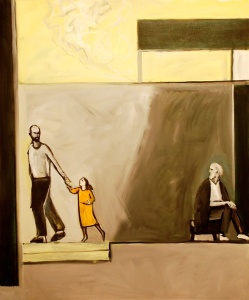Written by Menachem Wecker
When Richard McBee talks about Abraham and Sarah’s marriage, he calls it “a deeply problematic human relationship,” which leads him to ask, “Do we look at biblical figures as paradigms of behavior?”
McBee is not a therapist who thinks he is living in biblical times, nor is he an anti-theist seeking to undermine the bible. McBee, a painter, identifies as both a feminist and an Orthodox Jew, and as such, he is very concerned about how Abraham treated—or rather mistreated—his wife.
McBee is the first to admit that his biblical analysis is not original—not by several centuries. “I don’t believe for a moment that my ‘problems’ with the biblical text are unique,” he says. When he painted Sarah in a box being smuggled through Egyptian customs, he was quoting from a Midrash that states that Abraham hid Sarah in a box to protect her.
McBee’s innovation is wondering how Sarah felt to be locked up inside of a chest, as well as shifting the conversation from a literary understanding to a visual one. “That’s a shift that I think I wouldn’t necessarily expect someone to do unless they are a visual artist,” he says.
A series of 16 paintings of McBee’s on this subject was recently on exhibit in Sarah’s Trials at the Jewish Community Center of Manhattan. McBee says he received “an extraordinary amount” of feedback about the show, some of which came from people who were disturbed.
One work that particularly disturbed some people (and which made me laugh when I first saw it in McBee’s studio a few years ago) is Isaac Comforted.

“After Abraham buried me,” McBee writes in the caption to the work, which is expressed in the voice of his protagonist, Sarah, “he sent to his family in Haran for a child-bride for Isaac.”
In case you missed that point, the young girl in yellow holding Isaac’s hand is his wife, Rebecca. Before yielding to the temptation to report McBee to To Catch a Predator, consider that the interpretation comes from the medieval commentator Rashi in his interpretation of Genesis 25: 20.
According to Rashi:
- Abraham heard about Rebecca’s birth when he came to Mount Moriah.
- Isaac was 37-years-old when Abraham nearly sacrificed him (Sarah died at 127, had Isaac at 90, and she died just after the near-sacrifice)
- Isaac got married at 40.
- If Isaac was 37 when Rebecca was born, and he married her at 40, she was 3 at the time.
“He waited for her until she would be fit for marital relations—3 years—and then married her,” says Rashi, quoting from the Midrash Genesis Rabbah 57:1.
To the best of my knowledge, despite this Midrash, McBee is the first artist to depict a 3-year-old Rebecca with a 40-year-old Isaac. He also decided to included the seated Abraham, mourning the death of his wife Sarah. In what he describes as a “totally atextual” move, McBee’s Abraham turns back and looks at his son and his new bride.
“This pushes him to say, ‘I have to see what my life is going to be about,'” McBee says of Abraham’s revelation, “And he goes and marries this funny woman named Keturah, i.e. Hagar.”
In the next painting, McBee depicts Abraham walking down some stairs to meet his own younger bride, Keturah, whom the Midrash identifies with his previous wife-servant Hagar, mother of Ishmael. Nowhere does it say in the text that Abraham thought for a moment about Sarah when he married Keturah, but McBee paints the cemetery with Sarah’s tomb in the background.
It should be clear at this point that the Sarah series is all about women—and all about sex.
Another innovation of McBee’s in the series comes in the first painting in the series (perhaps the prelude), where McBee reinterprets another Midrash, this time about Abraham smashing all the idols in his father Terah‘s idol store. The young monotheistic Abraham, the Midrash says, decimated all the idols except one, and put a club in the hand of the sculpture that was still standing. When Terah demanded an explanation, Abraham said the idol, not he, was the culprit. Terah could hardly counter and say that idols couldn’t possibly do such a thing without compromising the integrity of his products.
McBee’s first painting shows Terah’s idol shop stocked with sculptures of nude Venuses, as well as Far Eastern nude female figures and some Gothic Madonnas-with-children. In the second painting, McBee depicts Abraham smashing one of the Venuses.
This move of showing Abraham’s struggle against idols representing the nude female form as foreshadowing and explaining Abraham’s later marital problems is totally original on McBee’s part.
It also explains the next two paintings in the series, where Abraham—dressed as a Hassid—sees no problem putting his wife in a box, and where an angel intervenes to protect Sarah from Pharaoh. According to the Midrash, Sarah instructed the angel to whip, and it whipped Pharaoh.
Not only has McBee sexualized the angel (who wears a mini-skirt), but he shows Sarah recoiling as the angel faces the tuxedo-clad king.
“That wasn’t something that I said ‘Aha, I want her to recoil.’ In trying to make her as a figure, she ended up pulling back a little bit, and only in retrospect did I say, ‘Aha, it’s not so easy,'” says McBee, explaining that Sarah might not have been able to so seamlessly assume a position of power.
“She’s a woman given a very powerful tool to use at her own will, but I’m saying in fact it’s more subtle than that,” he says. “She’s not that woman with her hands on her hips in total control. Maybe that kind of control provides its own problems.”
In the interests of full disclosure, I co-write a weekly column on Jewish arts with Richard McBee at The Jewish Press, where we have worked together for more than five years.
Posted by Menachem Wecker at November 7, 2010 07:31 PM